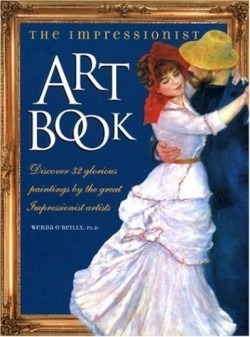The Impressionist Art Book
This lively, lyrical set of an illustrated book and a deck of cards will delight the eyes and instruct the minds of art lovers of all ages, from pre-readers to post-doctorates.
The author’s description of the world of the Impressionists in Paris during the Industrial Revolution is remarkably thorough, since the prose is so simple: “they wanted to capture spontaneous moments and fleeting reflections of light on people and things.” O’Reilly clearly depicts the revolution that these painters engendered in the art world, without canonizing them or demeaning their predecessors. A clever timeline places the period in worldwide context, and the eight artists (Manet, Degas, Pissaro, Morisot, Monet, Renoir, Cassatt, and Caillebotte) are each given a thumbnail biography, complete with portrait.
The author, who holds a doctorate in education from Stanford University and has also produced The Renaissance Art Book and Game, devotes several pages to each painter. Her comments are a wonderful introduction to (or refresher course in) art appreciation, drawing attention to techniques and details. She explains one reason that Renoir’s “Luncheon of the Boating Party” is so animated: “Look at one person in this painting, then notice where your eye goes next. You may want to follow that person’s gaze.”
Historical tidbits, anecdotes from the artists’ lives, descriptions of critics’ reactions, and quotations from the artists themselves are sprinkled throughout the pages, helping readers to understand the intentions of the painters and the societal barriers they had to overcome. Monet said, “I would like to paint the way a bird sings.” Cassatt and Morisot painted almost exclusively family members, since society did not permit a woman to ask a man to pose for her.
The accompanying deck of museum-quality cards comes with instructions for games, with versions for different ability levels. Each card shows a work of art, labeled with the title and artist, plus a list of other works by that artist. In the “Go Fish for Art” game, players try to collect all the cards of one artist. The “Masterpiece Memory” game is like “Concentration,” in which players place all the cards face down and try to match artists. The names of the artists are color-coded and numbered, and placed along the side of the card, making it easy for younger players to tell which painter they’re collecting.
O’Reilly is on to something. This gorgeous, well-researched book and beautiful, dynamic cards provide a perfect combination of education and entertainment.
Reviewed by
Karen McCarthy
Disclosure: This article is not an endorsement, but a review. The publisher of this book provided free copies of the book to have their book reviewed by a professional reviewer. No fee was paid by the publisher for this review. Foreword Reviews only recommends books that we love. Foreword Magazine, Inc. is disclosing this in accordance with the Federal Trade Commission’s 16 CFR, Part 255.

